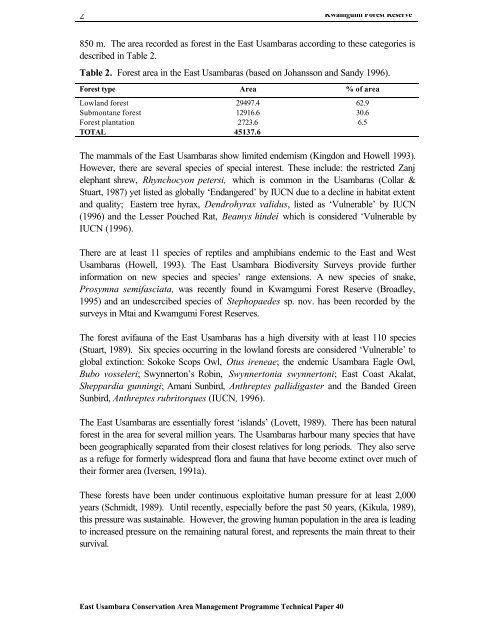Kwamgumi Forest Reserve - Frontier-publications.co.uk
Kwamgumi Forest Reserve - Frontier-publications.co.uk
Kwamgumi Forest Reserve - Frontier-publications.co.uk
Create successful ePaper yourself
Turn your PDF publications into a flip-book with our unique Google optimized e-Paper software.
2 <strong>Kwamgumi</strong> <strong>Forest</strong> <strong>Reserve</strong><br />
850 m. The area re<strong>co</strong>rded as forest in the East Usambaras ac<strong>co</strong>rding to these categories is<br />
described in Table 2.<br />
Table 2. <strong>Forest</strong> area in the East Usambaras (based on Johansson and Sandy 1996).<br />
<strong>Forest</strong> type Area % of area<br />
Lowland forest 29497.4 62.9<br />
Submontane forest 12916.6 30.6<br />
<strong>Forest</strong> plantation 2723.6 6.5<br />
TOTAL 45137.6<br />
The mammals of the East Usambaras show limited endemism (Kingdon and Howell 1993).<br />
However, there are several species of special interest. These include: the restricted Zanj<br />
elephant shrew, Rhynchocyon petersi, which is <strong>co</strong>mmon in the Usambaras (Collar &<br />
Stuart, 1987) yet listed as globally ‘Endangered’ by IUCN due to a decline in habitat extent<br />
and quality; Eastern tree hyrax, Dendrohyrax validus, listed as ‘Vulnerable’ by IUCN<br />
(1996) and the Lesser Pouched Rat, Beamys hindei which is <strong>co</strong>nsidered ‘Vulnerable by<br />
IUCN (1996).<br />
There are at least 11 species of reptiles and amphibians endemic to the East and West<br />
Usambaras (Howell, 1993). The East Usambara Biodiversity Surveys provide further<br />
information on new species and species’ range extensions. A new species of snake,<br />
Prosymna semifasciata, was recently found in <strong>Kwamgumi</strong> <strong>Forest</strong> <strong>Reserve</strong> (Broadley,<br />
1995) and an undescrcibed species of Stephopaedes sp. nov. has been re<strong>co</strong>rded by the<br />
surveys in Mtai and <strong>Kwamgumi</strong> <strong>Forest</strong> <strong>Reserve</strong>s.<br />
The forest avifauna of the East Usambaras has a high diversity with at least 110 species<br />
(Stuart, 1989). Six species occurring in the lowland forests are <strong>co</strong>nsidered ‘Vulnerable’ to<br />
global extinction: Sokoke S<strong>co</strong>ps Owl, Otus ireneae; the endemic Usambara Eagle Owl,<br />
Bubo vosseleri; Swynnerton’s Robin, Swynnertonia swynnertoni; East Coast Akalat,<br />
Sheppardia gunningi; Amani Sunbird, Anthreptes pallidigaster and the Banded Green<br />
Sunbird, Anthreptes rubritorques (IUCN, 1996).<br />
The East Usambaras are essentially forest ‘islands’ (Lovett, 1989). There has been natural<br />
forest in the area for several million years. The Usambaras harbour many species that have<br />
been geographically separated from their closest relatives for long periods. They also serve<br />
as a refuge for formerly widespread flora and fauna that have be<strong>co</strong>me extinct over much of<br />
their former area (Iversen, 1991a).<br />
These forests have been under <strong>co</strong>ntinuous exploitative human pressure for at least 2,000<br />
years (Schmidt, 1989). Until recently, especially before the past 50 years, (Kikula, 1989),<br />
this pressure was sustainable. However, the growing human population in the area is leading<br />
to increased pressure on the remaining natural forest, and represents the main threat to their<br />
survival.<br />
East Usambara Conservation Area Management Programme Technical Paper 40

















